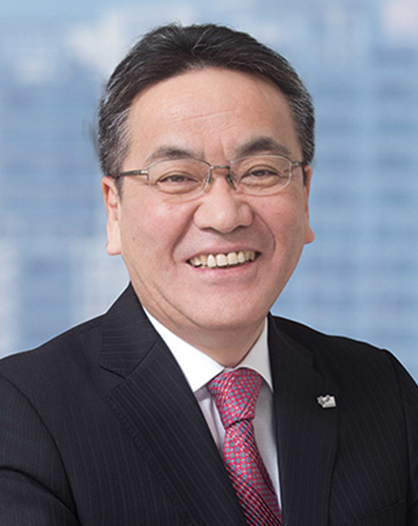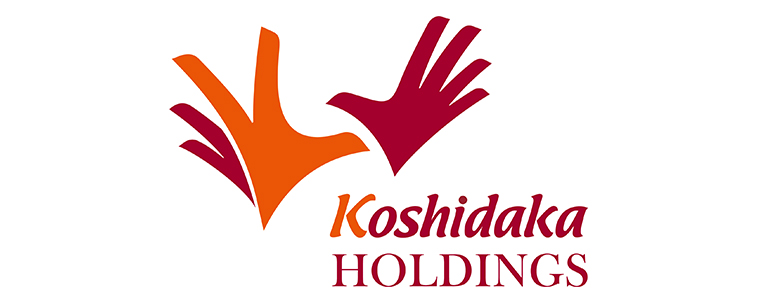| Koshidaka HOLDINGS Co., Ltd. (2157) |
|
||||||||
Company |
Koshidaka HOLDINGS Co., Ltd. |
||
Code No. |
2157 |
||
Exchange |
First Section, Tokyo Stock Exchange |
||
Industry |
Service |
||
President |
Hiroshi Koshidaka |
||
HQ Address |
World Trade Center Building 23rd Floor, 2-4-1 Hamamatsucho, Minato-ku, Tokyo |
||
Year-end |
August |
||
URL |
|||
* Share price as of close on October 23, 2018. Outstanding shares as of most recent quarter end, excluding treasury stock. ROE and BPS are actual results from the previous term.
|
||||||||||||||||||||||||
|
|
* Estimates are those of the company. From fiscal year August 2016, the definition of net profit has been changed to net profit attributable to parent company shareholders. (The same shall apply hereinafter.)
* A 4-for-1 stock split was conducted in June 2018.(EPS and DPS have been revised retroactively)。 This Bridge Report presents an overview of Koshidaka HOLDINGS's earnings results for fiscal year August 2018 and earnings estimates for full fiscal year August 2019. |
|
| Key Points |
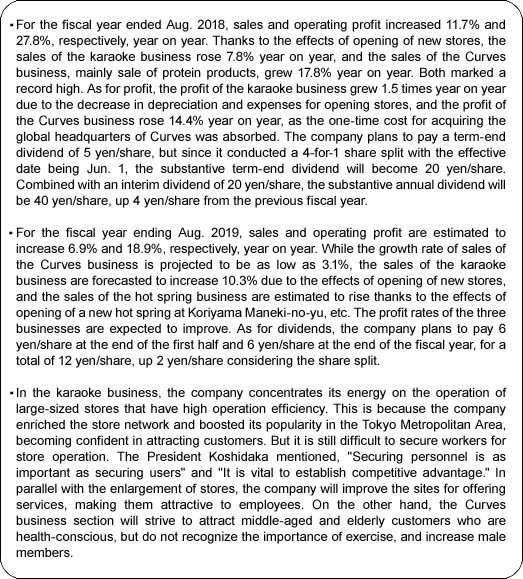 |
| Company Overview |
|
Koshidaka HOLDINGS Co., Ltd. is a "comprehensive entertainment and leisure services provider" and it promotes a strategy of "creating new businesses in existing industries" in the four realms of "amusement," "sports and fitness," "tourism and travel," and "hobbies and cultural activities." Based upon its two main cornerstones of the karaoke club business and Curves Fitness Club business, Koshidaka has been able to continue to grow both sales and profits since its listing and is cultivating new businesses such as its hot spring facilities, which is becoming a steadfast contributor to earnings. Moreover, Koshidaka seeks to create new value addition through its strategy of "creating new businesses in existing industries" based upon the theme of "leisure."
<Corporate Philosophy - Contribute to the Creation of a Peaceful World by Providing Bountiful Hope and Lifestyles Rich with Entertainment>
Koshidaka maintains a corporate philosophy of "contributing to the creation of a peaceful world by providing bountiful hope and lifestyles rich with entertainment, while continuing to provide evolutionary and significant services and products to people worldwide." Based upon this corporate philosophy, Koshidaka has also established five visions: 1) cultivating new businesses in existing industries to provide easily accessible entertainment that only requires a short amount of time, and is close and reasonable, 2) developing optimized businesses and structures based upon conditions in each country, area, and industry, 3) continuing to offer surprising and highly satisfying services and products with customers' needs in mind, 4) fostering inspired and entrepreneurial human resources, and 5) seeking to cultivate and maximize synergies between the various businesses of the group.
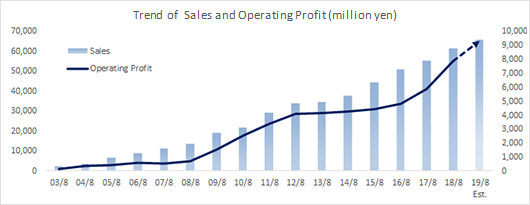 <Business Segments>
The Koshidaka HOLDINGS Group currently divides its business into four main segments: karaoke club, Curves Fitness Club, hot spring and real estate management businesses. In the karaoke business segment, the company operates both the "Karaoke Honpo Manekineko" clubs and "One Kara" individual use karaoke clubs. In the Curves Fitness Club business, fitness clubs providing 30 minutes workout programs specialized for middle to older aged female users called "Curves" are operated. Furthermore, the hot spring business (leveraging various hot spring facility operation knowhow), and real estate management businesses are also being undertaken. In the fiscal year ended Aug. 2018, they accounted for 51.7%, 45.2%, 2.6%, and 0.5%, respectively, of sales and 36.2%, 61.4%, 0.8%, and 1.5%, respectively, of operating profit before consolidation adjustment.
The karaoke business was successfully differentiated with high-quality services and low prices, and the number of stores in Japan is the second largest in this industry. The company operates this business also in South Korea, Singapore, and Malaysia. The Curves business ranked first in transaction volume, the number of stores, and the number of members in this field. The company acquired the global headquarters in Mar. 2018. As of the end of the fiscal year ended Aug. 2018, the company had 520 karaoke stores (and 23 overseas stores), 1,912 Curves facilities, 827,000 members, and 5 hot spring facilities. <Business Segments>
The Koshidaka HOLDINGS Group currently divides its business into four main segments: karaoke club, Curves Fitness Club, hot spring and real estate management businesses. In the karaoke business segment, the company operates both the "Karaoke Honpo Manekineko" clubs and "One Kara" individual use karaoke clubs. In the Curves Fitness Club business, fitness clubs providing 30 minutes workout programs specialized for middle to older aged female users called "Curves" are operated. Furthermore, the hot spring business (leveraging various hot spring facility operation knowhow), and real estate management businesses are also being undertaken. In the fiscal year ended Aug. 2018, they accounted for 51.7%, 45.2%, 2.6%, and 0.5%, respectively, of sales and 36.2%, 61.4%, 0.8%, and 1.5%, respectively, of operating profit before consolidation adjustment.
The karaoke business was successfully differentiated with high-quality services and low prices, and the number of stores in Japan is the second largest in this industry. The company operates this business also in South Korea, Singapore, and Malaysia. The Curves business ranked first in transaction volume, the number of stores, and the number of members in this field. The company acquired the global headquarters in Mar. 2018. As of the end of the fiscal year ended Aug. 2018, the company had 520 karaoke stores (and 23 overseas stores), 1,912 Curves facilities, 827,000 members, and 5 hot spring facilities.
 【Koshidaka Group】 【Koshidaka Group】
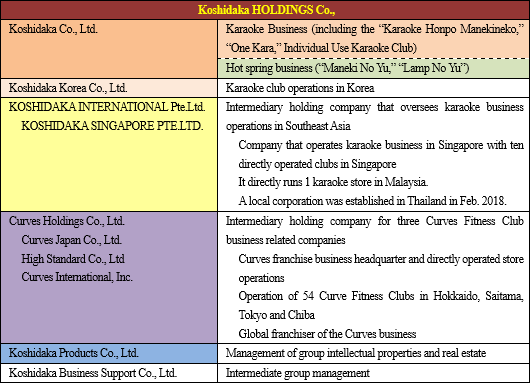 The non-consolidated subsidiaries include English Island Co., Ltd., which uses the television conference software application "Skype" to provide English lessons with native English speaking teachers living overseas, EEIKAIWA, Inc., and Koshidaka R&C Co., Ltd.
The non-consolidated subsidiaries include English Island Co., Ltd., which uses the television conference software application "Skype" to provide English lessons with native English speaking teachers living overseas, EEIKAIWA, Inc., and Koshidaka R&C Co., Ltd.
 *ROA = Net Profit Margin ×Asset Turnover Ratio、ROE = Net Profit Margin × Asset Turnover Ratio × Leverage
* The figures above are calculated using earnings results and assets data from official financial reports. Total assets and equity are averages of the balance during the term (average of balance at the end of previous term and current term). Equity ratio taken from official financial filings is calculated based on balance at the end of term. So, the reciprocal number and leverage do not necessarily match. *ROA = Net Profit Margin ×Asset Turnover Ratio、ROE = Net Profit Margin × Asset Turnover Ratio × Leverage
* The figures above are calculated using earnings results and assets data from official financial reports. Total assets and equity are averages of the balance during the term (average of balance at the end of previous term and current term). Equity ratio taken from official financial filings is calculated based on balance at the end of term. So, the reciprocal number and leverage do not necessarily match.
|
| Fiscal Year August 2018 Earnings Results |
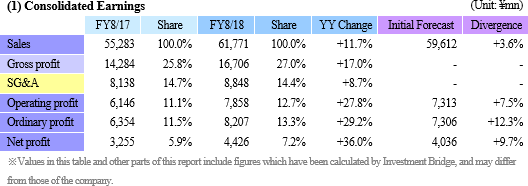 Sales and operating profit grew 11.7% and 27.8%, respectively, year on year.
Sales were 61,771 million yen, up 11.7% year on year. Thanks to the effects of opening of new stores, the sales of the karaoke business rose 7.8% year on year, and the sales of the Curves business grew 17.8% year on year, as the sales of protein products increased. Both marked a record high.
As for profit, the profit of the karaoke business grew 53.8% year on year as profitability improved due to the decrease in depreciation and expenses for opening stores, and the profit of the Curves business rose 14.4% year on year, thanks to sales growth. Consolidated operating profit increased 27.8% year on year to 7,858 million yen, marking a record high. Non-operating profit/loss improved due to the increase in exchange gain (from 79 million yen to 302 million yen), and extraordinary profit/loss improved due to the decline in impairment loss and loss on retirement of non-current assets. As for extraordinary loss, 520 million yen was posted, including the impairment loss of unamortized balance of goodwill of KOSHIDAKA INTERNATIONAL PTE. LTD., which is an intermediate holding company for the karaoke business in Southeast Asia (435 million yen). Sales and operating profit grew 11.7% and 27.8%, respectively, year on year.
Sales were 61,771 million yen, up 11.7% year on year. Thanks to the effects of opening of new stores, the sales of the karaoke business rose 7.8% year on year, and the sales of the Curves business grew 17.8% year on year, as the sales of protein products increased. Both marked a record high.
As for profit, the profit of the karaoke business grew 53.8% year on year as profitability improved due to the decrease in depreciation and expenses for opening stores, and the profit of the Curves business rose 14.4% year on year, thanks to sales growth. Consolidated operating profit increased 27.8% year on year to 7,858 million yen, marking a record high. Non-operating profit/loss improved due to the increase in exchange gain (from 79 million yen to 302 million yen), and extraordinary profit/loss improved due to the decline in impairment loss and loss on retirement of non-current assets. As for extraordinary loss, 520 million yen was posted, including the impairment loss of unamortized balance of goodwill of KOSHIDAKA INTERNATIONAL PTE. LTD., which is an intermediate holding company for the karaoke business in Southeast Asia (435 million yen).
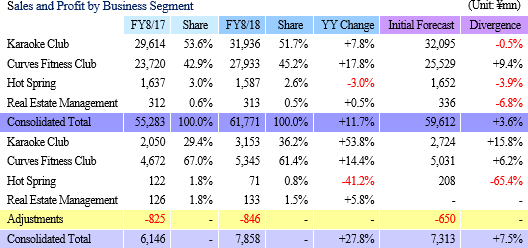 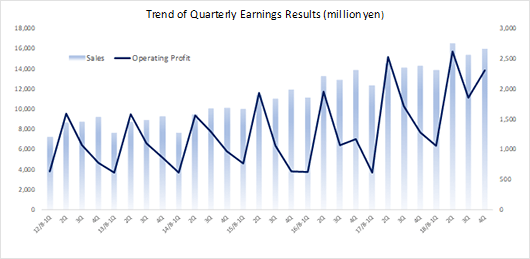  Inside Japan, the company opened 31 stores (including 18 stores in downtown areas around stations), and closed 10 stores. Accordingly, the number of stores as of the end of the fiscal year was 520 (499 as of the end of the previous fiscal year). The number of newly opened stores is decreasing, because the company is enlarging stores while rigorously selecting real estate as the store network in the Tokyo Metropolitan Area has been well developed and the capability of reeling in customers increased through the enhancement of brand competitiveness. In addition, the company renewed 42 stores (37 stores in the previous fiscal year). Existing stores saw a 100.8% increase thanks to the good performance of stores in the Tokyo Metropolitan Area (102.5% for the number of customers, 98.4% for average spending per customer)
Sales grew 2,322 million yen in value terms. The opening of new stores, including those in the previous fiscal year, accounts for 2,508 million yen, while existing stores make up 231 million yen. Overseas sales declined 45 million yen, and there emerged a sales decreasing factor of 372 million yen.
As for profit, gross profit rate rose 0.1 points, and SG&A dropped, as depreciation decreased 219 million yen, expenses for opening stores declined 184 million yen, and cost for equipment and supplies decreased 71 million yen.
Inside Japan, the company opened 31 stores (including 18 stores in downtown areas around stations), and closed 10 stores. Accordingly, the number of stores as of the end of the fiscal year was 520 (499 as of the end of the previous fiscal year). The number of newly opened stores is decreasing, because the company is enlarging stores while rigorously selecting real estate as the store network in the Tokyo Metropolitan Area has been well developed and the capability of reeling in customers increased through the enhancement of brand competitiveness. In addition, the company renewed 42 stores (37 stores in the previous fiscal year). Existing stores saw a 100.8% increase thanks to the good performance of stores in the Tokyo Metropolitan Area (102.5% for the number of customers, 98.4% for average spending per customer)
Sales grew 2,322 million yen in value terms. The opening of new stores, including those in the previous fiscal year, accounts for 2,508 million yen, while existing stores make up 231 million yen. Overseas sales declined 45 million yen, and there emerged a sales decreasing factor of 372 million yen.
As for profit, gross profit rate rose 0.1 points, and SG&A dropped, as depreciation decreased 219 million yen, expenses for opening stores declined 184 million yen, and cost for equipment and supplies decreased 71 million yen.
 The number of overseas stores as of the end of the fiscal year was 23 (24 as of the end of the previous fiscal year). In Singapore, there were burdens of increased depreciation for the renewal of 3 major stores and the development cost for karaoke devices targeted at Southeast Asia. In addition, a subsidiary in Malaysia took over 1 store (32 rooms), and started operating it in July.
The number of overseas stores as of the end of the fiscal year was 23 (24 as of the end of the previous fiscal year). In Singapore, there were burdens of increased depreciation for the renewal of 3 major stores and the development cost for karaoke devices targeted at Southeast Asia. In addition, a subsidiary in Malaysia took over 1 store (32 rooms), and started operating it in July.
 The number of Curves stores inside Japan as of the end of the fiscal year was 1,912 (including 61 stores directly managed by the corporate group), up 89 (4.8%) from the end of the previous fiscal year, and the number of members was 827,000, up 6,000 (0.7%). Members in their 50s account for 21.5%, those in their 60s account for 38.5%, and those in 70s make up 29.3% (and members in their 40s account for 7.4% and those in their 30s and younger members make up 3.3%). Members in their 50s and older members account for 89.3%.
Sales grew 4,213 million yen in value terms. Thanks to the healthy performance of protein products after the release of new products, shopping sales (about 14.4 billion yen) increased 4,062 million yen, most contributing to sales growth in this segment. As for FC-related revenue, temporary revenue related to the opening of FC stores, such as the revenue from franchise fees, decreased 569 million yen, but basic sales, which are continuous revenue from royalties, etc., increased 422 million yen. In addition, the sales from directly managed stores grew 297 million yen.
As for profit, the augmentation of SG&A due to the posting of 545 million yen as temporary expenses for acquiring the global headquarters of Curves was absorbed.
The number of Curves stores inside Japan as of the end of the fiscal year was 1,912 (including 61 stores directly managed by the corporate group), up 89 (4.8%) from the end of the previous fiscal year, and the number of members was 827,000, up 6,000 (0.7%). Members in their 50s account for 21.5%, those in their 60s account for 38.5%, and those in 70s make up 29.3% (and members in their 40s account for 7.4% and those in their 30s and younger members make up 3.3%). Members in their 50s and older members account for 89.3%.
Sales grew 4,213 million yen in value terms. Thanks to the healthy performance of protein products after the release of new products, shopping sales (about 14.4 billion yen) increased 4,062 million yen, most contributing to sales growth in this segment. As for FC-related revenue, temporary revenue related to the opening of FC stores, such as the revenue from franchise fees, decreased 569 million yen, but basic sales, which are continuous revenue from royalties, etc., increased 422 million yen. In addition, the sales from directly managed stores grew 297 million yen.
As for profit, the augmentation of SG&A due to the posting of 545 million yen as temporary expenses for acquiring the global headquarters of Curves was absorbed.
 Without opening new facilities, the company upgraded existing facilities by renewing them and enriching their food menus, but sales declined slightly, due to the drop in average spending per customer. As for profit, there was the burden of increased energy cost, although SG&A was reduced through the labor saving and streamlining by automatic ticket vending machines and ordering terminals.
Without opening new facilities, the company upgraded existing facilities by renewing them and enriching their food menus, but sales declined slightly, due to the drop in average spending per customer. As for profit, there was the burden of increased energy cost, although SG&A was reduced through the labor saving and streamlining by automatic ticket vending machines and ordering terminals.
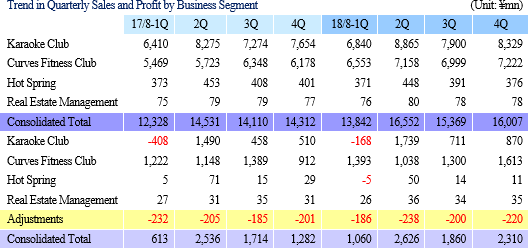  Term-end total assets were 68,357 million yen, up 24,667 million yen from the end of the previous fiscal year. As the company acquired the global headquarters of Curves, the company posted 20,559 million yen as trademarks in the section of intangible assets, and goodwill increased 931 million yen from 1,034 million yen to 1,965 million yen (about 1,550 million yen for the global headquarters of Curves). In addition, deferred tax liabilities in the section of fixed liabilities augmented 4,908 million yen from 119 million yen to 5,028 million yen. Capital adequacy ratio was 37.5% (49.6% as of the end of the previous fiscal year).
Term-end total assets were 68,357 million yen, up 24,667 million yen from the end of the previous fiscal year. As the company acquired the global headquarters of Curves, the company posted 20,559 million yen as trademarks in the section of intangible assets, and goodwill increased 931 million yen from 1,034 million yen to 1,965 million yen (about 1,550 million yen for the global headquarters of Curves). In addition, deferred tax liabilities in the section of fixed liabilities augmented 4,908 million yen from 119 million yen to 5,028 million yen. Capital adequacy ratio was 37.5% (49.6% as of the end of the previous fiscal year).
 While operating CF declined due to the augmentation of tax expenses from 1,923 million yen to 4,105 million yen, the deficit of investment CF expanded as 18,405 million yen was spent for acquiring the global headquarters of Curves. The company coped with the demand for funds, with long-term debts amounting to 18,297 million yen, etc.
While operating CF declined due to the augmentation of tax expenses from 1,923 million yen to 4,105 million yen, the deficit of investment CF expanded as 18,405 million yen was spent for acquiring the global headquarters of Curves. The company coped with the demand for funds, with long-term debts amounting to 18,297 million yen, etc.
|
| Fiscal Year August 2019 Earnings Estimates |
 Sales and operating profit are estimated to grow 6.9% and 18.9%, respectively, year on year.
Sales are projected to increase 6.9% year on year to 66,044 million yen. While the growth rate of sales of the Curves business, which is about to be on a plateau, is projected to be as low as 3.1%, the sales of the karaoke business are forecasted to increase 10.3% due to the effects of opening of new stores, and the sales of the hot spring business are estimated to rise thanks to the effects of opening of a new hot spring at Koriyama Maneki-no-yu, etc.
Operating profit is forecasted to rise 18.9% year on year to 9,345 million yen. Operating profit rate is expected to improve, as the profitability of the karaoke business will increase further due to sales growth, the decline in depreciation, etc. and there will be no longer temporary expenses for acquiring the global headquarters in the Curves business. The profit of the hot spring business is estimated to grow considerably due to sales growth, energy saving measures, and revision to food menus. Sales and operating profit are estimated to grow 6.9% and 18.9%, respectively, year on year.
Sales are projected to increase 6.9% year on year to 66,044 million yen. While the growth rate of sales of the Curves business, which is about to be on a plateau, is projected to be as low as 3.1%, the sales of the karaoke business are forecasted to increase 10.3% due to the effects of opening of new stores, and the sales of the hot spring business are estimated to rise thanks to the effects of opening of a new hot spring at Koriyama Maneki-no-yu, etc.
Operating profit is forecasted to rise 18.9% year on year to 9,345 million yen. Operating profit rate is expected to improve, as the profitability of the karaoke business will increase further due to sales growth, the decline in depreciation, etc. and there will be no longer temporary expenses for acquiring the global headquarters in the Curves business. The profit of the hot spring business is estimated to grow considerably due to sales growth, energy saving measures, and revision to food menus.
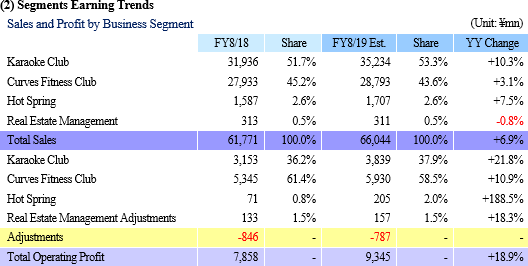 Karaoke Club Business
The company plans to open 35 new stores mainly in downtown areas around stations in the Tokyo metropolitan area (assuming about 2/3 of new stores). The size of stores is increasing. Opening of 55-room stores in the Omiya Nishiguchi branch and Shinjuku Nishiguchi branch is already decided, and there is also a plan of opening 60-room stores. It will also continue to revive existing stores through renovation. In stores, in addition to simplifying the flow of entering stores and introducing automatic checkout machines, it also promotes centralization of office work in the head office and aims for automation and streamlining. In addition to continuing to work on receiving the certification of "Premium Malts Master Store" for all stores and collaborating between "Tsukiji Gindako and Manekineko," it is also striving on differentiation in terms of eating and drinking, by introducing new items.
With the idea of promoting the use of karaoke rooms, the company is also focusing on offering smartphone applications. In addition to launching the "Omaneki Party" app through which users can join other groups using karaoke "Manekineko" in June, it began offering the member service "Manekineko app" in October. When users install the "Omaneki Party" app and check in "Manekineko" through the application, they can get a "Check-in Coupon" with which, they will receive a 20% discount in the usage fee. Furthermore, by exchanging message with other users through the application, users can acquire "Omaneki Party Coupon" which gives a 50% discount of the total fee after joining the other group (installation of applications, joining, message exchanges, etc. are free). Meanwhile, "Manekineko app" has functions such as a point system, a rank-up system, mini games, nearest shop search, and notification from favorite shops. Furthermore, the company is also planning to offer a kitting system to project movies etc. of mobile terminals, and it will work on providing entertainment other than karaoke by developing new services.
In overseas markets, it plans to open the second Malaysian store in November and the first Thai store in February 2019, and in Indonesia, it has established a representative office and started market research. Currently, it is the only Japanese karaoke business operator in Southeast Asia. It is planning to develop in the entire Southeast Asia, which is a blue ocean, including joint ventures in countries where capital regulations are in place.
Curves Fitness Club Business
The company plans to open a total of 86 new stores combining regular stores and amoeba stores (described later). Opening amoeba stores means opening of sister stores within the business area of the stores where the number of members exceeds the capacity (600 to 650 people). Although it is limited to the case where there is a potential commercial area, it aims to construct a store network that makes it easy for existing members to visit the store. Current Curves members are highly motivated to be healthy and do exercise, but in the future the company will continue to focus on targeting people who want to be healthy but are not motivated to do exercise. The most frequent reasons for joining Curves are introduction (52%), followed by newspaper inserts (19%), signs (11%), and others (18%). Strengthening service through exercise instruction, communication, and community will lead to improvement of satisfaction of existing members, improvement of continuation rate, increase of members due to word of mouth and introduction and increase of shopping sales due to increase of members.
In addition, as part of the efforts to develop new business fields, the company will open a test store of Men's Curves (targeting men) in November. Men's Curves (2F) will be located on the upstairs of the Curves Ogino Chino store (1F) in Chino, Nagano Prefecture. It will test the effect of introduction/word of mouth from the Curves members. In addition, it is currently making efforts to understand the situation of Curves in various countries across the world, in order to show some policy toward global expansion during this fiscal year.
Hot Spring Business
Although the company is not planning to open new stores, it will strengthen the customer attraction by attracting more female customers, appealing security and safety, opening new hot springs at Koriyama Manekinoyu and renewing existing services, etc. It will also work on improving work efficiency by further making energy-saving efforts and reviewing the meals menu.
(3) Shareholder Return
As for dividends, the company plans to pay 6 yen/share at the end of the first half and 6 yen/share at the end of the fiscal year, for a total of 12 yen/share, up 2 yen/share considering the share split. As benefits for shareholders, the company distributes complimentary coupons and catalogues for choosing favorite gifts. This time, the company started offering more benefits to shareholders who have held shares for a long period of time. Karaoke Club Business
The company plans to open 35 new stores mainly in downtown areas around stations in the Tokyo metropolitan area (assuming about 2/3 of new stores). The size of stores is increasing. Opening of 55-room stores in the Omiya Nishiguchi branch and Shinjuku Nishiguchi branch is already decided, and there is also a plan of opening 60-room stores. It will also continue to revive existing stores through renovation. In stores, in addition to simplifying the flow of entering stores and introducing automatic checkout machines, it also promotes centralization of office work in the head office and aims for automation and streamlining. In addition to continuing to work on receiving the certification of "Premium Malts Master Store" for all stores and collaborating between "Tsukiji Gindako and Manekineko," it is also striving on differentiation in terms of eating and drinking, by introducing new items.
With the idea of promoting the use of karaoke rooms, the company is also focusing on offering smartphone applications. In addition to launching the "Omaneki Party" app through which users can join other groups using karaoke "Manekineko" in June, it began offering the member service "Manekineko app" in October. When users install the "Omaneki Party" app and check in "Manekineko" through the application, they can get a "Check-in Coupon" with which, they will receive a 20% discount in the usage fee. Furthermore, by exchanging message with other users through the application, users can acquire "Omaneki Party Coupon" which gives a 50% discount of the total fee after joining the other group (installation of applications, joining, message exchanges, etc. are free). Meanwhile, "Manekineko app" has functions such as a point system, a rank-up system, mini games, nearest shop search, and notification from favorite shops. Furthermore, the company is also planning to offer a kitting system to project movies etc. of mobile terminals, and it will work on providing entertainment other than karaoke by developing new services.
In overseas markets, it plans to open the second Malaysian store in November and the first Thai store in February 2019, and in Indonesia, it has established a representative office and started market research. Currently, it is the only Japanese karaoke business operator in Southeast Asia. It is planning to develop in the entire Southeast Asia, which is a blue ocean, including joint ventures in countries where capital regulations are in place.
Curves Fitness Club Business
The company plans to open a total of 86 new stores combining regular stores and amoeba stores (described later). Opening amoeba stores means opening of sister stores within the business area of the stores where the number of members exceeds the capacity (600 to 650 people). Although it is limited to the case where there is a potential commercial area, it aims to construct a store network that makes it easy for existing members to visit the store. Current Curves members are highly motivated to be healthy and do exercise, but in the future the company will continue to focus on targeting people who want to be healthy but are not motivated to do exercise. The most frequent reasons for joining Curves are introduction (52%), followed by newspaper inserts (19%), signs (11%), and others (18%). Strengthening service through exercise instruction, communication, and community will lead to improvement of satisfaction of existing members, improvement of continuation rate, increase of members due to word of mouth and introduction and increase of shopping sales due to increase of members.
In addition, as part of the efforts to develop new business fields, the company will open a test store of Men's Curves (targeting men) in November. Men's Curves (2F) will be located on the upstairs of the Curves Ogino Chino store (1F) in Chino, Nagano Prefecture. It will test the effect of introduction/word of mouth from the Curves members. In addition, it is currently making efforts to understand the situation of Curves in various countries across the world, in order to show some policy toward global expansion during this fiscal year.
Hot Spring Business
Although the company is not planning to open new stores, it will strengthen the customer attraction by attracting more female customers, appealing security and safety, opening new hot springs at Koriyama Manekinoyu and renewing existing services, etc. It will also work on improving work efficiency by further making energy-saving efforts and reviewing the meals menu.
(3) Shareholder Return
As for dividends, the company plans to pay 6 yen/share at the end of the first half and 6 yen/share at the end of the fiscal year, for a total of 12 yen/share, up 2 yen/share considering the share split. As benefits for shareholders, the company distributes complimentary coupons and catalogues for choosing favorite gifts. This time, the company started offering more benefits to shareholders who have held shares for a long period of time.
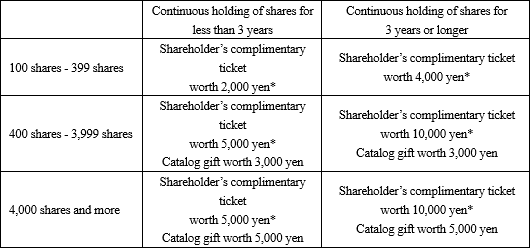 |
| Conclusions |
|
In the karaoke business, the company concentrates its energy on the operation of large-sized stores that have high operation efficiency. This is because the company enriched the store network and boosted its popularity in the Tokyo Metropolitan Area, becoming confident in attracting customers. But it is still difficult to secure workers for store operation. The President Koshidaka mentioned, "Securing personnel is as important as securing users" and "It is vital to establish competitive advantage." In parallel with the enlargement of stores, the company will improve the sites for offering services, making them attractive to employees.
There is good news for personnel affairs. It is a bill for amending the immigration law for accepting more foreign workers. Its objective is to establish a new status of residence so that they will become able to engage in simple labor work. The bill will be deliberated at an extraordinary Diet session on Oct. 24. The company hopes to take advantage of the shift of the immigration policy.
|
| <Reference: Regarding Corporate Governance> |
 ◎ Corporate Governance Report
Updated on December 4, 2017
Basic Policy
The basic policy for corporate governance of our corporate group is to achieve swift decision making and flexible organizational operation for strengthening our corporate competitiveness amid the rapidly changing business environment, while keeping the transparency and soundness of business administration for maximizing the corporate value with respect to shareholders, and we have developed systems and implemented some measures for it. The important mission in our business administration is to achieve sustainable growth and improve our medium and long-term corporate value. In order to fulfill this mission, our corporate group has fostered good relationships with all stakeholders, including shareholders and customers, while respecting their respective standpoints, and set our group's "management philosophy" and "behavioral standards" for following the philosophy.
Corporate Mission
Our mission is to contribute to the realization of lifestyles full of leisure and to the establishment of a peaceful world filled with hope by continuing to create, offer and provide the world with new and meaningful products and services.
<Reasons for Non-Compliance with the Principles of the Corporate Governance Code (Excerpts)>
【Supplementary Principle 1-2-4 Exercise of rights at a General Shareholders' Meeting】
The company provides the English translation of brief financial reports, but it does not allow the exercise of voting rights on a digital platform nor does it provide the English translation of convocation notices considering the aspects of operation and efficiency. The company shall consider the change of shareholder composition ratio and ensure continuous improvement in the environment as necessary.
【Supplementary Principal 4-1-3 Role/Responsibilities of Board of Directors (1)】
The Board of Directors does not supervise the plans regarding successors of CEO, etc., however, BOD and others will have much discussion on concrete management policies and strategies and will be selecting successors of CEO, etc. from a comprehensive perspective.
<Disclosure Based on the Principles of the Corporate Governance Code (Excerpts)>
【Principle 1-4 The so-called strategically held shares】
The basic policy of our company is not to hold shares strategically.
【Principle 1-7 Transactions among parties concerned】
In our company, important transactions with executives and major shareholders (transactions among parties concerned) are determined by the board of directors. For each account settlement, directors and major shareholders are obligated to submit a written confirmation about whether they have conducted any transactions among parties concerned.
【Principle 5-1 Policy for developing systems and implementing measures for promoting constructive dialogue with shareholders】
(Basic policy)
Through constructive dialogue with shareholders, we will deepen their understanding of our company, achieve sustainable growth, and improve our medium and long-term corporate value.
(Division in charge)
If a shareholder requests a dialogue (meeting), the division in charge of IR will deal with the request. After confirming the purpose, etc. of the dialogue (meeting) of the shareholder, the management, including the executive in charge of the IR division, will hold a meeting, if necessary.
(Means for dialogue other than individual meetings)
In our company, directors disclose information regularly through results briefing sessions, etc.
(Prevention of the leakage of insider information)
As for the management of insider information, our company prevents the leakage of insider information by managing information rigorously in accordance with the in-company regulations for inside information management and the prevention of insider trading. ◎ Corporate Governance Report
Updated on December 4, 2017
Basic Policy
The basic policy for corporate governance of our corporate group is to achieve swift decision making and flexible organizational operation for strengthening our corporate competitiveness amid the rapidly changing business environment, while keeping the transparency and soundness of business administration for maximizing the corporate value with respect to shareholders, and we have developed systems and implemented some measures for it. The important mission in our business administration is to achieve sustainable growth and improve our medium and long-term corporate value. In order to fulfill this mission, our corporate group has fostered good relationships with all stakeholders, including shareholders and customers, while respecting their respective standpoints, and set our group's "management philosophy" and "behavioral standards" for following the philosophy.
Corporate Mission
Our mission is to contribute to the realization of lifestyles full of leisure and to the establishment of a peaceful world filled with hope by continuing to create, offer and provide the world with new and meaningful products and services.
<Reasons for Non-Compliance with the Principles of the Corporate Governance Code (Excerpts)>
【Supplementary Principle 1-2-4 Exercise of rights at a General Shareholders' Meeting】
The company provides the English translation of brief financial reports, but it does not allow the exercise of voting rights on a digital platform nor does it provide the English translation of convocation notices considering the aspects of operation and efficiency. The company shall consider the change of shareholder composition ratio and ensure continuous improvement in the environment as necessary.
【Supplementary Principal 4-1-3 Role/Responsibilities of Board of Directors (1)】
The Board of Directors does not supervise the plans regarding successors of CEO, etc., however, BOD and others will have much discussion on concrete management policies and strategies and will be selecting successors of CEO, etc. from a comprehensive perspective.
<Disclosure Based on the Principles of the Corporate Governance Code (Excerpts)>
【Principle 1-4 The so-called strategically held shares】
The basic policy of our company is not to hold shares strategically.
【Principle 1-7 Transactions among parties concerned】
In our company, important transactions with executives and major shareholders (transactions among parties concerned) are determined by the board of directors. For each account settlement, directors and major shareholders are obligated to submit a written confirmation about whether they have conducted any transactions among parties concerned.
【Principle 5-1 Policy for developing systems and implementing measures for promoting constructive dialogue with shareholders】
(Basic policy)
Through constructive dialogue with shareholders, we will deepen their understanding of our company, achieve sustainable growth, and improve our medium and long-term corporate value.
(Division in charge)
If a shareholder requests a dialogue (meeting), the division in charge of IR will deal with the request. After confirming the purpose, etc. of the dialogue (meeting) of the shareholder, the management, including the executive in charge of the IR division, will hold a meeting, if necessary.
(Means for dialogue other than individual meetings)
In our company, directors disclose information regularly through results briefing sessions, etc.
(Prevention of the leakage of insider information)
As for the management of insider information, our company prevents the leakage of insider information by managing information rigorously in accordance with the in-company regulations for inside information management and the prevention of insider trading.
Disclaimer
This report is intended solely for informational purposes, and is not intended as a solicitation to invest in the shares of this company. The information and opinions contained within this report are based on data made publicly available by the Company, and comes from sources that we judge to be reliable. However we cannot guarantee the accuracy or completeness of the data. This report is not a guarantee of the accuracy, completeness or validity of said information and or opinions, nor do we bear any responsibility for the same. All rights pertaining to this report belong to Investment Bridge Co., Ltd., which may change the contents thereof at any time without prior notice. All investment decisions are the responsibility of the individual and should be made only after proper consideration.Copyright(C) 2018, Investment Bridge Co., Ltd., All Rights Reserved. |

